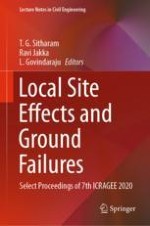2021 | OriginalPaper | Buchkapitel
Reliability-Based Assessment of Liquefaction Potential Using SPT Approach
verfasst von : G. S. Bhatia, K. Bhargava, A. Mondal
Erschienen in: Local Site Effects and Ground Failures
Verlag: Springer Singapore
Aktivieren Sie unsere intelligente Suche, um passende Fachinhalte oder Patente zu finden.
Wählen Sie Textabschnitte aus um mit Künstlicher Intelligenz passenden Patente zu finden. powered by
Markieren Sie Textabschnitte, um KI-gestützt weitere passende Inhalte zu finden. powered by
